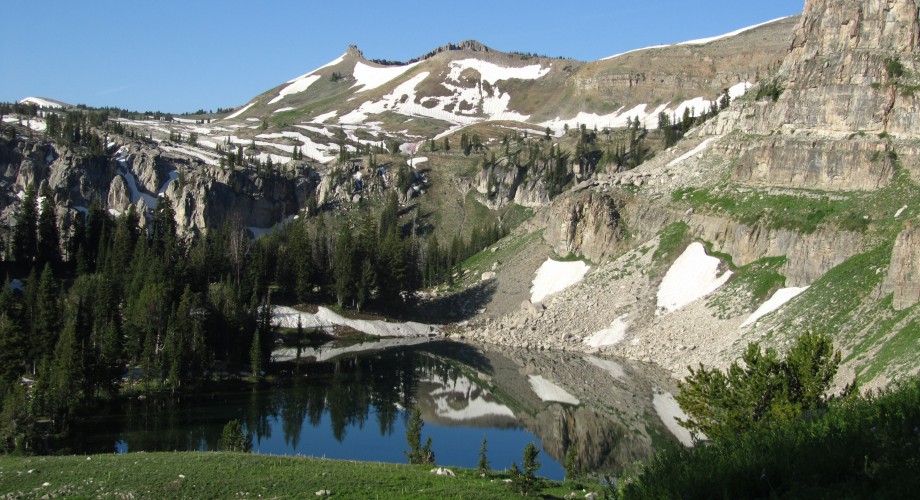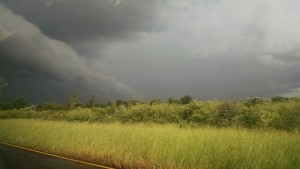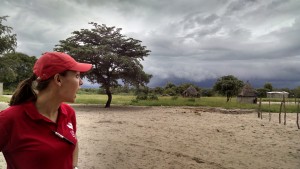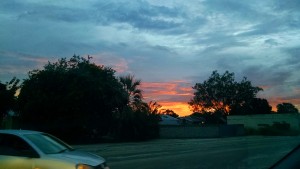On Tuesday morning I got introduced to the “situation room”. This is a container office that UCSF paid for and had installed at the Katima Mulilo Hospital, which is where the Ministry of Health has their regional offices. It is still getting set up and right now there’s just a table and three chairs inside, but once the burglar bars get installed on the windows, a projector, computer, and printer will live there permanently. Two white boards have been installed and four more are on their way.
Each team stays in the office one day and week and on that day, the team leader (Flavian or Simataa) go to the Situation Room to use the online database to pick out which cases to follow up on that week. The container got that name because Kate jokingly called it that one day and all of the staff picked up on it. I think it’s quite fitting. The container is placed there, instead of at the UNAM office, so that we can easily meet with Ministry of Health malaria team. Our study is taking place in their area and it was agreed that we would follow up on all cases in our study area and the MoH would work on all others. But since the rains started a few weeks ago, there is a huge outbreak of malaria going on and this has lead to some tough conversations with the Ministry about who has jurisdiction. The MoH wants to test and treat everyone, which is great, but would completely invalidate our study. But they don’t have the staff or resources to actually do that, so we have tried to convince them to follow up on cases outside of our area and then if they finish with those (which is highly unlikely), they can work in our areas as well. I’m not sure how that is going to work out.
Anyway, I got introduced to the online reporting system and how the team leaders go about deciding what cases to investigate that week. Then I went back to the office, joined the one team going out to the field and we packed up and headed out.
The rainy season typically starts in October to December but this year it didn’t start until the of January. Last year it was even worse: there was no long rainy season. The result has been severe drought and that has meant failed crops for most people in the area who rely on subsistence farming to live. The government has started giving out food aid, mostly in the form of rice and corn meal (maize meal or pap as it is called here) but it is not enough and people are dying of starvation. And since the rains started so late, it is hard to say if the crops will grow well enough before winter sets in. The situation is getting pretty dire and I feel so bad for everyone here.
This has also added another challenge to our study. When we approached a new village to start a case investigation, many people were not home and their neighbors reported that they were out waiting for their food aid. They often have to walk several kilometers (very few people have cars here) then wait in line before walking home (carrying a 30 pound bag of corn meal) so it is difficult to predict how long that process takes or when someone will be back.
As the teams interviewed and tested the people who were home, Kate and I watched the clouds roll in on a stiff wind.
It is very flat here, and you could definitely call it Big Sky Country, so the clouds always look very dramatic.
Sometimes there is an awning or shelter (i.e. tin roof supported by sticks but no walls) built by the community where we can do the interviews and testing/treatment, but most of the time we just set up underneath the largest tree in the area which provides the most shade and get to work there. When it is windy, papers and study supplies get blown around and when it’s raining, well, there are issues.
The wind really picked up in the afternoon and you could see the storm coming, so Kate and I started setting up the gazebo that we brought along, but it was too big and awkward for just the two of us to set up. We got Simataa and Braster (one of the drivers) to help, and the four of us working together managed to raise the roof and put on one wall. But now we had created a sail and the stakes we put into the sand did very little to hold the gazebo in place. By the time we got it set up and moved our supplies underneath, a few more of the villagers returned with their food aid. We thought we could enroll and test them then, but they and everyone else who had gathered started running for their houses to get out of the rain and to start preparing food. There was no point in hanging around so we started packing up while the wind speed continued to increase. We got the gazebo down (it was only set up for about 10 minutes) and got most of the supplies in the back of the bakkie when it started to rain.
We quickly jumped in the truck and headed back. At first the rain was just a steady stream, but pretty soon the clouds really opened up and let loose. It rained so hard you could hardly see anything out of the front windshield. Even Simataa started taking video of the storm and he’s from here!
It was such a long distance from where we were to the office that we actually drove through the storm and by the time we got back, it was only sprinkling in Katima. But there were a lot of puddles (i.e. mosquito breeding grounds) and new potholes in the road. On the drive back Kate and I discussed options for the teams when it is raining so hard. This could go on for months so it’s not like we can just not go out and wait for the weather to improve, but we don’t have a great plan yet and it’s definitely something that we have to work out.
The up side to a big storm is an amazing sunset. I always think that the sunsets in Africa are some of the best I’ve seen and I wasn’t disappointed that night as we left the office and saw this:




